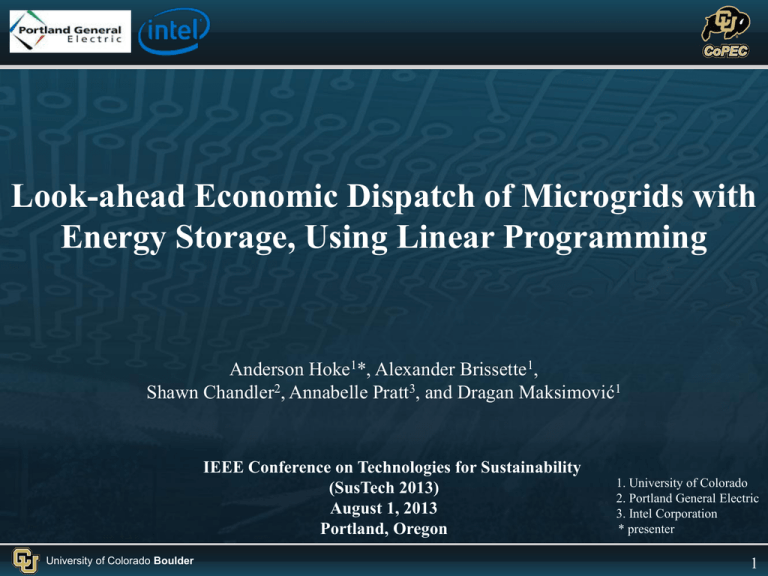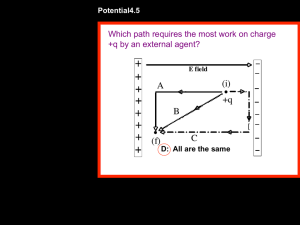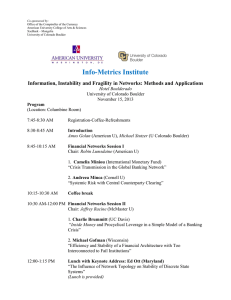presentation
advertisement

Look-ahead Economic Dispatch of Microgrids with
Energy Storage, Using Linear Programming
Anderson Hoke1*, Alexander Brissette1,
Shawn Chandler2, Annabelle Pratt3, and Dragan Maksimović1
IEEE Conference on Technologies for Sustainability
(SusTech 2013)
August 1, 2013
Portland, Oregon
University of Colorado Boulder
1. University of Colorado
2. Portland General Electric
3. Intel Corporation
* presenter
1
What is a microgrid?
Microgrid: section of the power grid that can disconnect and operate independently
• Often a neighborhood, university campus, military base, industrial campus,
single building, or distribution feeder
• Must contain internal energy sources
• Typically contains energy storage: during a grid fault, inverter-based storage
can pick up load fast enough to prevent an outage
• Primary benefit is reliability
• Secondary benefits:
• Single entity from power system operator’s perspective, potentially
simplifying integration of distributed/renewable energy
• Internal sources and storage can be operated for economic benefit
University of Colorado Boulder
2
How to maximize economic benefit when grid-tied
Many microgrids are grid-tied >99% of the time
Problem: How to optimize economics of microgrid operation?
Given a microgrid with:
• Dispatchable generators
• Battery
• Demand response resources
• Photovoltaic
• Loads
• Dynamic electricity prices
Goal: meet load demand at lowest marginal cost
When should each resource be turned on (and at what power)?
University of Colorado Boulder
3
Assumptions
Several predictions are available hours or days in advance (e.g. 72 hours):
• Predicted load profile
• Predicted PV output
• Predicted cost of grid electricity
Pdem = Pload - _PPV
PPV
Pload
Pdem
University of Colorado Boulder
4
Possible solutions
Simple-minded approach:
•
Divide 72-hour window into multiple intervals
•
Assign cost to each resource during each interval
•
Choose the cheapest resources to meet the load
•
Doesn’t account for battery SOC
•
Stored energy is a time-coupling mechanism
Linear programming (LP) can account for SOC limits
•
Optimizes all intervals simultaneously
•
Well-tested, has known convergence properties, fast
•
Can’t account for:
•
Battery conversion losses
•
Discrete generator power setpoints
•
Resource run-time constraints (e.g. maximum daily runtime)
Mixed-integer linear programming can account for SOC limits, losses, power discretization,
run-time constraints
•
Much slower (NP-hard)
Other approaches (genetic algorithm, particle swarm, etc)
•
Global minimum generally not guaranteed, long computation times
University of Colorado Boulder
5
Linear Programming
Our chosen solution uses linear programming (fast, reliable)
Why is computation speed important in emerging smart grid applications?
• Time interval lengths under consideration decreasing, vastly increasing the
number of variables in a given time window
• Frequency of optimization is increasing. Pacific NW Smart Grid Demo
Project nodes re-optimize every five minutes
• Emerging control methods (e.g. transactive control) optimize iteratively
How we adapt LP:
• Auxiliary variables trick LP into accounting for battery losses
• LP solution post-processed to account for discrete constraints
University of Colorado Boulder
6
Basic LP setup
• n future time intervals under optimization: i = {i1, i2, …, in}
• Interval lengths: {∆t1, ∆t2, …, ∆tn}
(e.g. {5, 5, …, 15, …, 180) [minutes]
• Working variables: grid power Pg,i, dispatchable generator power Pd,i, storage power
Ps,i, demand response power PDR,i
• Sources of same type and cost aggregated into single variable
• Cost of power from each source during each interval: cg,i, cd,i, cs,i, cDR,I
min Pr ,i ti cr ,i
• Objective function:
Pr
r
where r {g , d , s, DR}
i
“Minimize cost of power”
• Subject to:
P
r ,i
Pdem,i Pload ,i Pn ,i i
r
“Generation meets demand”
University of Colorado Boulder
7
Inequality constraints
• Power limits of sources provide inequality constraints:
𝑃𝑟, 𝑚𝑖𝑛 ≤ 𝑃𝑟, 𝑖 ≤ 𝑃𝑟, 𝑚𝑎𝑥 ∀ 𝑖, 𝑟
“Stay within resource power limits”
• Typically Pd,min and PDR,min are 0
• Pg,min = 0 if power exportation not allowed
• Energy stored, E, has minimum Emin, maximum Emax, and initial value E0, leading to
constraints:
𝑖
𝐸𝑚𝑖𝑛 ≤ 𝐸0 +
𝑖𝑥=1
𝑃𝑠, 𝑖𝑥∆𝑡𝑖𝑥 ≤ 𝐸𝑚𝑎𝑥 ∀𝑖
“Stay within SOC limits”
• This assumes 100% efficiency for energy entering and leaving storage
• For a microgrid where storage may be cycled daily, this is a bad assumption
University of Colorado Boulder
8
Conversion loss accounting
• Storage conversion losses are nonlinear:
Ploss
Ps
• But they are approximately piecewise linear
• Define auxiliary variables:
• Power leaving storage (before losses)
0,
• 𝑃𝑠𝑜𝑢𝑡, 𝑖 =
𝑃𝑠 𝑖
,
𝜂𝑜𝑢𝑡
𝑥<0
, 𝑥≥0
• Power entering storage (after losses)
• 𝑃𝑠𝑖𝑛, 𝑖 =
−𝑃𝑠, 𝑖 𝜂𝑖𝑛,
0,
𝑥<0
𝑥≥0
• Psout and Psin can be used to directly find the energy stored: 𝐸𝑖 = 𝐸0 +
University of Colorado Boulder
𝑖
𝑖𝑥=1(𝑃𝑠𝑜𝑢𝑡 , 𝑖
+ 𝑃𝑠𝑖𝑛, 𝑖 )
9
Auxiliary constraints
• The auxiliary variables require auxiliary constraints to link them to existing variables:
𝑃𝑠𝑜𝑢𝑡, 𝑖 ≥ 0 ∀𝑖 and 𝑃𝑠𝑖𝑛, 𝑖 ≥ 0 ∀𝑖
“Psout and Psin are always positive or zero”
𝑃𝑠, 𝑖 = 𝑃𝑠𝑜𝑢𝑡 , 𝑖 𝜂𝑜𝑢𝑡 −
𝑃𝑠𝑖𝑛, 𝑖
∀𝑖
𝑛𝑖𝑛
“Storage power is linked to Psout and Psin”
• New, more accurate energy storage inequality constraints:
𝑖
𝐸𝑚𝑖𝑛 ≤ 𝐸0 +
𝑖𝑥=1
𝑃𝑠𝑖𝑛, 𝑖𝑥 − 𝑃𝑠𝑜𝑢𝑡 , 𝑖𝑥 ∆𝑡𝑖𝑥 ≥ 𝐸𝑚𝑎𝑥 ∀𝑖
“SOC stays within limits”
• Note: These equations rely on Psin and Psout never being simultaneously nonzero
• This is a binary constraint and can’t be expressed in LP
University of Colorado Boulder
10
Modified objective function
• Need to ensure Psout and Psin are never simultaneously nonzero
• Modify objective function to apply small costs csout and csin to Psout, Psin
min ti Psout ,i csout ,i Psin,i csin ,i Pr ,i ti cr ,i where r2 {g , d , s, DR, sout , sin}
Pr2
i
r
“Minimize cost of power, plus small cost to avoid solutions
where storage is simultaneously charged and discharged”
University of Colorado Boulder
11
Post-processing
• Dispatchable microgrid resources may have nonlinear constraints such as
• Minimum turn-on notice
• Maximum run-time during a period (e.g. day, year)
• Minimum off-time before turn-on, minimum on-time before turn-off
• Discrete power setpoints
• The constraints are applied using a series of hueristic post-processing steps, briefly
summarized here:
1. Round LP solution to achieve discrete power setpoints
2. Dis-aggregate any aggregated resources
3. Address minimum on-time and minimum off-time constraints
4. Address maximum run-time constraints
5. Adjust storage power to meet load, if needed
6. Adjust grid power to meet load, if needed
• Result remains very close to LP solution, but is no longer guaranteed optimal
University of Colorado Boulder
12
Simulated microgrid
Simulated using data from a Portland General Electric microgrid
• Medium voltage utility feeder “high reliability zone” (HRZ)
• Part of Pacific Northwest Smart Grid Demonstration Project
• 72-hour look-ahead window
• 122 time intervals: Δti varies from
5 mins (at beginning) to 3 hrs (at
end of window)
• Pload is measured microgrid feeder
load for July 5-7, 2011; varies
between 1.5 MW and 3.5 MW;
• cgrid is actual MIDC hourly price
for July 5-7, 2011; varies between
-2 $/MWh and 522 $/MWh
University of Colorado Boulder
13
Simulated microgrid
Model of PGE microgrid developed in microgrid modeling platform
2x 1.275MW Gen
2x 800kW Gen
2x 800kW Gen
120kW PV
Control
algorithms
University of Colorado Boulder
1.25MWh, 5MW
120kW DR
14
Results
75% SOC
error when
neglecting
losses
University of Colorado Boulder
15
Results
• Total cost to meet load over 72 hours: $7,027
• Penalty due to meeting nonlinear constraints: $50 (0.7%, varies)
• Cost if using only grid and PV power: $9,675.
• Resource optimization results in 27% savings
• >50% if bulk power exportation allowed
• Largely due to price spike
• Processing time: 2 to 4 seconds on 2 GHz PC in script-based Matlab
University of Colorado Boulder
16
Results
•
A more typical 3-day period
•
5% savings over grid+PV alone
•
Because only battery, grid, and PV are used, this solution is true optimum (no hueristics)
•
Battery cycles 4 times in 3 days, but does not respond to all local cost minima
University of Colorado Boulder
17
Neglecting storage losses
• Excessive battery cycling (at all local minima)
• Uneconomical, even neglecting the excessive storage degradation
University of Colorado Boulder
18
Thanks for listening!
• Questions?
University of Colorado Boulder
19
Modified LP approach
Pricing
signal
cr,i
SOC
LP core
Pre-processing
Load, PV
forecast
Previous
P*r,i
constrained
Pr,i
P*r,i
Post-processing
optimization
24-hour minimum
turn-on notice:
may exclude DR’s
from optimization
Can be
overridden by an
emergency flag
University of Colorado Boulder
Various nonlinear or timing
constraints
• Generators can run only at
nominal power, or at discrete
fixed power levels
• Maximum daily and annual
generator runtimes
• Minimum generator off-time
before turn-on
20
Microgrid simulation tool
Simulation platform to support investigations of architectural, control and optimization
techniques in microgrids
“Building” block is fundamental unit; configure by combining common resources
“Control & Weather” block contains algorithms for microgrid-level control
Matlab/Simulink/SimPower; phasor domain (1 & 3)
1
AC1
AC1
AC2
AC2
AC1
2
Passive Loads
HVAC
AC2
External Control
1
Grid
14.4kV
60Hz
AC1
2
2
AC1
AC2
AC2
Building #1
1
Ground
AC1
3
Smart Breaker
node 10
PV
Dryer
AC2
14.4kV:480V
AC1
AC1
AC1
Building #2
AC2
AC2
Generator
Dishwasher
AC2
AC1
2
AC1
AC1
Building #3
1
3
node 10
AC2
AC2
AC2
Battery
14.4kV:240V
AC1
AC1
Building #4
AC2
Water Heater
Control&Weather
AC2
EV
HEMS
University of Colorado Boulder
21



